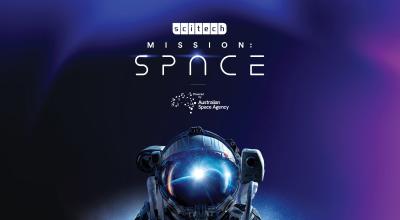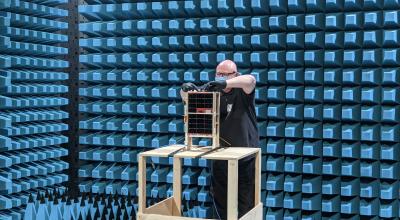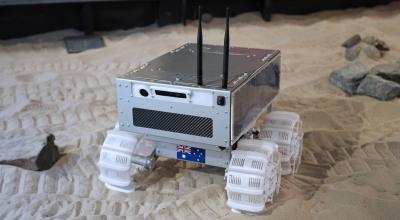The Australian Space Agency and EOS Space Systems signed a Statement of Strategic Intent and Cooperation which aligns with the Australian Civil Space Strategy.
L-R: EOS Space Systems CEO, Professor Craig Smith and Australian Space Agency Deputy Head, Anthony Murfett
Read the full statement
The Commonwealth of Australia as represented by the Australian Space Agency, part of the Department of Industry, Innovation and Science, hereinafter referred to as “the Agency” and represented by Mr Anthony Murfett, Deputy Head, Australian Space Agency, and EOS Space Systems Pty Ltd, hereinafter referred to as "EOS Space Systems" and represented by Professor Craig Smith, Chief Executive Officer, EOS Space Systems Pty Ltd;
Recalling that the Australian Civil Space Strategy 2019-2028 is a framework for the development and growth of the Australian space industry over ten years, underpinned by four strategic pillars: International; National; Responsible; and Inspire. Under these pillars the strategy endeavours to help realise opportunities and address challenges by opening doors internationally; increasing national space capability; promoting responsible regulation, risk and space culture; and building the future workforce. The Strategy sets a path for the Agency to triple the size of Australia’s space sector to $12 billion and create another 20,000 jobs by 2030;
Recalling that the Agency's purpose is to transform and grow a globally respected Australian space industry that lifts the broader economy, inspires and improves the lives of Australians – underpinned by strong international and national engagement;
Recalling that the Agency has seven National Civil Space Priority Areas including communications technologies and services; position, navigation and timing infrastructure; space situational awareness and debris monitoring; leapfrog research and development; Earth observation services; robotics and automation on Earth and in space; and access to space;
Recalling that the Agency’s responsibilities include: whole-of-government coordination of Australia's civil space sector matters, providing primary civil space policy and strategic advice to the Australian Government, supporting the growth of our national space industry and the use of space across the broader economy, leading international civil space engagement, administering space activities legislation and completing our international obligations, and inspiring both the Australian community and the next generation of space entrepreneurs;
Recalling that EOS Space Systems is a decades-established Australian company specialising in the design, manufacture and operation of Space Situational Awareness (SSA) and control components for applications in satellite communications and remote manoeuvre, timing and navigation, object tracking, identification, characterisation and monitoring, ground-based telescope, laser and imaging systems, network-control, and observatories;
Recalling EOS Space Systems’ considerable experience with active and passive ground-based space sensor systems, equipping the company to provide research and development, training, space asset management and debris risk mitigation to Australia’s space sector;
Recalling that EOS Space Systems’ strategic purpose is to provide Australian owned and operated capability as a global leader in autonomous space tracking systems that support sovereign and international customers through:
- Widespread existing infrastructure for tracking, characterisation and independent cataloguing of space objects with accuracy and sensitivity exceeding current standards for commercial space operations, from low earth orbit to beyond geostationary orbit, and applicable to 90% of all collision risks to operational spacecraft;
- Design, manufacture and operation of one of the world’s first automated sensor network;
- Australia-exclusive space capability development, and;
- Space data analysis, collision probability elimination and autonomous network control.
Recalling EOS Space Systems’ considerable experience with low-bandwidth, extreme-range optical communications, including supply of sub-systems for optical communications, space laser tracking system infrastructure with secure and reliable optical communications functionality, launch of its own Westpac satellite for optical communications testing, and achievement of a 6.7-million-kilometre optical communications link between a Mt Stromlo transmitter and JAXA’s Hayabusa2 spacecraft;
Recalling EOS Space Systems’ anticipated growth, and activity in areas of increasing importance and market demand;
Recalling EOS Space Systems’ considerable national and international presence, including six operational space sensor sites and two research centres within Australia, production facilities within Australia and the United States, a production support depot within Singapore, and offices within Canberra, Alabama and Arizona (United States), Abu Dhabi (United Arab Emirates), and Deggendorf (Germany);
Recalling EOS Space Systems’ participation in Space Environment Research Centre (SERC) collaborations with the Australian National University (ANU), Royal Melbourne Institute of Technology (RMIT), Lockheed Martin, Optus and the National Institute of Information and Communications Technology (NICT) Japan;
Acknowledging that the Agency and EOS Space Systems share the objective of enhancing the capability and competitiveness of Australian industry, and promoting investments in space capabilities and capacities that will support growth and highly qualified jobs as well as improving the day-to-day lives of all Australians through innovative products and services;
Acknowledging that the Agency is part of the Australian government and is committed to open, transparent and significant industry engagement;
Acknowledging that EOS Space Systems has a proven history of building and supporting ground-based optical laser tracking facilities and space control networks, and will leverage its experience to deliver space debris management options and optical communications ground station reception capability to support the objectives of the Australian Civil Space Strategy;
Through this Statement, EOS Space Systems acknowledges the following current projects, areas of strategic interest and growth, potential new areas of collaboration and support for education and training which are of interest to the nation.
Space Situational Awareness
EOS currently operates a highly capable SSA network with 6 sensors at two locations (Mt Stromlo ACT and Learmonth WA). This network is able to acquire 10,000 high precision space object tracks per week.
Over the next five years EOS will expand the network capacity tenfold to attain a planned capacity of 100,000 high precision space tracks per week, addressing long-term space information requirements for domestic and international space operators. New sensor sites will be established in Queensland, South Australia, Western Australia and the Northern Territory. The new sensor sites will bring advanced technology and high tech jobs in infrastructure and systems operations in areas of regional Australia.
EOS has made investments of $200 million towards SSA research and development, spanning projects in space debris tracking, monitoring and analysis, orbital prediction toolset development, collision-avoidance prediction and informatics software development, EOS will continue to invest in R&D, new technologies and facilities to remain a world leader in delivery of SSA services;
Development of a Mt. Stromlo-situated laser tracking system capable of re-orbiting space debris via photonic pressure, as well as supporting satellite payloads, with more powerful laser tracking systems expected to follow;
Space Traffic Management and Missions Systems to support regulatory requirements
EOS Space Systems will support space traffic management providing tracking systems that monitor Australian owned space objects.
EOS Space Systems has developed advanced capabilities and algorithms in astrodynamics and in partnership with SERC has developed one of the most advanced conjunction analysis and threat warning (CATW) system available.
EOS Space Systems will package the CATW and orbit prediction capabilities to provide a Space Traffic Management Mission System (STMMS) and plans to invest in and establish a Missions System Command and Control Data Centre at new facilities at Jerrabomberra. This data centre will support all Australian based senor and data types, including optical, radar and RF sensing systems amongst others.
Optical Communications
Operation of space laser tracking systems as communication terminals to provide secure, high-speed satellite up-link and down-link, with future transition to optical communication bandwidths exceeding 1 terabit per second (Tbps).
Education
Supporting development of space professionals through educational science, technology, engineering, mathematics (STEM) programs and internships.
Through SERC, EOS has supported dozens of interns and over 40 PhD scholarships over the past 5 years. EOS will continue to develop a work force of space professionals by offering student placements as well as long term space careers for technicians, degrees and higher degree scientists and engineers. All applications for EOS scholarships and internships are considered on their merit with no minimum or maximum quotas. EOS especially supports opportunities for women in the space industry.
This Statement constitutes the expression of both parties' intent to continue discussions, collaboration and engagement. This statement does not create any legal relations or obligations between the parties, and does not establish an obligation to enter into any agreement.









